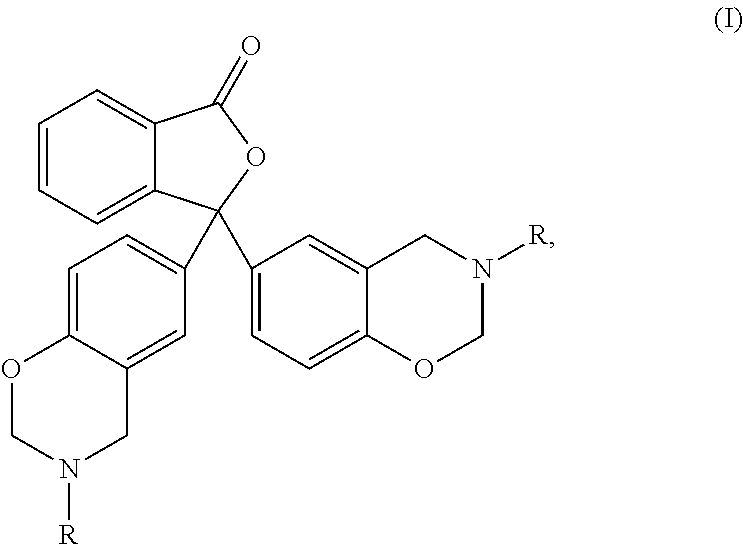Photocurable compositions for preparing abs-like articles
a composition and abs technology, applied in the field of clear, low viscosity photocurable compositions, can solve the problems of sl resin, process of depth control/accuracy, and inability to toughen/improve mechanical properties
- Summary
- Abstract
- Description
- Claims
- Application Information
AI Technical Summary
Benefits of technology
Problems solved by technology
Method used
Image
Examples
examples
[0109]The general procedure used for preparing three-dimensional articles with stereolithography equipment is as follows. The photocurable composition is placed in a vat designed for use with the stereolithography equipment. The photocurable composition is poured into the vat within the machine at about 30° C. The surface of the composition, either in its entirety or in accordance with a predetermined pattern, is irradiated with a UV / VIS light source so that a layer of a desired thickness is cured and solidified in the irradiated area. A new layer of the photocurable composition is formed on the solidified layer. The new layer is likewise irradiated over the entire surface or in a predetermined pattern. The newly solidified layer adheres to the underlying solidified layer. The layer formation step and the irradiation step are repeated until a green model of multiple solidified layers is produced.
[0110]A “green model” is a three-dimensional article initially formed by the stereolitho...
examples 1-4
[0120]
Example 1Example 3ComparativeExample 2ComparativeExample 4Epalloy 500040.938.436.934.4Erisys GE 3012121212CN23015555SR833S20.120.120.120.1Cyclohexane02.502.5dimethanol(component (1))Terathane 10000044(component (1))Acclaim 1220015151515(component (2))IRG 1842222CPI69765555Example1Comparative234E4 (mJ / cm2)52.155.846.043.9Colour (L*)65726974
[0121]It has been surprisingly found that the addition of a small amount of component (1) to comparative composition 1, allows to fabricate a white solid part when submitting the clear liquid compositions 2, 3 and 4 (L* equal or greater than 69). The parts manufactured by UV-curing composition 1 show a slight opalescence and do not appear white to the eye (L* is smaller than 69). This increase in whiteness, when adding a small amount of component (1), was unexpected. While not willing to be bound to any theory, the inventors attribute it to an increase in the extend of the phase separation of component (2), enhanced by component (1).
[0122]In ...
examples 5-22
[0124]The following examples show the extend of this unexpected invention. A number of components (1) have been evaluated, with various chemical structures. Most of them are alcohols of various functionality, class, molecular weights. An acrylate and an epoxy have also been evaluated as component (1).
Component (1)OH-numberTrade nameSourceMW (g / mol)FunctionalityClass(mg KOH / g)IsopropanolSigma-601secondary60AldrichDiethylene glycolSigma-1062Primary53Aldrich2,3-ButanediolSigma-902Secondary45AldrichPinacolSigma-1182Tertiary59AldrichCyclohexaneSigma-1442Primary57dimethanolAldrichTerathane 250Invista2502Primary125(polytetrahydrofuran)Terathane 650Invista6502Primary325(polytetrahydrofuran)Terathane 1000Invista10002Primary500(polytetrahydrofuran)Desmophen PU21IK01Bayer48002.8-3.2n / a1500-1700(branched polyether-based polyol)CD406 (CyclohexaneSartomer2522 / 0dimethanol diacrylate)Grilonite F-713EMS-8902 / 0(epoxidisedPrimidpolytetrahydrofuran)
[0125]TERATHANE® is a polytetramethyleneetherglycol al...
PUM
 Login to View More
Login to View More Abstract
Description
Claims
Application Information
 Login to View More
Login to View More - R&D
- Intellectual Property
- Life Sciences
- Materials
- Tech Scout
- Unparalleled Data Quality
- Higher Quality Content
- 60% Fewer Hallucinations
Browse by: Latest US Patents, China's latest patents, Technical Efficacy Thesaurus, Application Domain, Technology Topic, Popular Technical Reports.
© 2025 PatSnap. All rights reserved.Legal|Privacy policy|Modern Slavery Act Transparency Statement|Sitemap|About US| Contact US: help@patsnap.com



